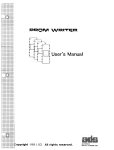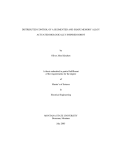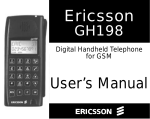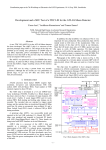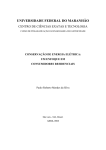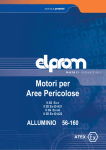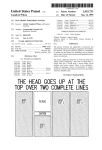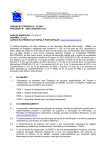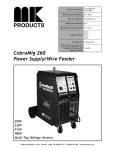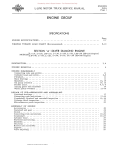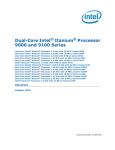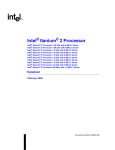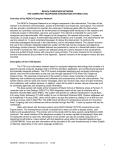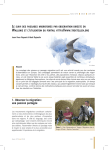Download Find Name <
Transcript
‘
US005758295A
United States Patent [191
[11]
Patent Number:
Ahlberg et a1.
[451
Date of Patent:
[54]
UNIFORM MAN-MACHINE INTERFACE
FOR CELLULAR MOBILE TELEPHONES
[75] Inventors: Bjorn Gustav Dinese Ahlberg.
Falsterbo. Sweden; Anders Lennart
Molne. Cary. NC; Johan Falk.
15mm?!» Sweden
‘
_
_
‘
5,758,295
May 26, 1998
(B79233
2253362
3/1933
1/1994
European Pal 05- United Kingdom -
92/14331
8/1992
WIPO .
95/23485
8/1995 WIPO‘
OTHER PUBLICATIONS
Telcom Report. vol. 16. No. 6. Nov. 1993. “GSM Handy Mit
Top Handling". pp. 332-335.
[73] As?gnec: Telefmak?ebdg“ LM Emss°n~
Swed?n
Electrical Communication. N0. 4. 1993. New Intuitive
Screenphones for Advance Telephony Services. pp.
380-386.
[21]
[22]
Annual Review of Communications International Engineer
ing Consortium. vol. 47. 1993/94. “User Interface Issues For
Appl' No‘: 777’002
Filed:
Jan. 3, 1997
Cellular Phones". pp. 679-685.
Related US. Application Data
Primary Examiner-Dwayne Bost
[63]
Continuation of Ser. No. 213,704, Mar. 16. 1994, aband°n°¢
Assistant Examiner—William G. Trost
Attorney, Agent, or Firm-Burns. Doane. Swecker &
[511
[52]
[58]
Im. Cl.6 ..................................................... .. H04Q 7/32
US. Cl. ......................... .. 455/566; 455/550; 379/396
Mathis LLP
[57]
ABSTRACT
Field of Search ................................... .. 379/425. 433.
379/396; 345/146_ 169; 455/5 5()_ 566_ 564_
575g 9()_ 552_ 553
[56]
A mobile radio terminal includes a display for outputting at
least one menu. The menu includes at least one branch for
processing telephone calls. Each of the branches includes at
least one option for choosing a corresponding action to be
References Cited
performed by the radio terminal. the corresponding actions
U'S' Pm DOCUMENTS
5130993
5,127,042
5,128,981
5,335,355
5,425,077
511991
6/1992
7/1992
3/1994
6/1995
5436954
7/1995 N‘Shiyama e‘ “1'
5,509,048
4/1996 Meidan et a1.
$555,502
9/1996 Opel ........ ..
5,561,712 10/1996
5,579,535 11/1996
5,581,593 12/1996
including causing a successive branch to be displayed and
pitch _
Gilljg et a1. ........................ .. 379/61 X
Tsukamoto et a1. .................. .. 455/450
Tamika Bl 31- Tsoi ......................................... .. 379/58
Nishihara
performing a terminal function. The mobile terminal
includes a selection mechanism for designating one of the
options. A first key is included for con?rming selection of
the option designated by the selection means. so as to move
forward through the manu to a succeeding branch and
379/58
perform the corresponding action chosen by the con?rmed
..... .. 379/58
0 don and for Ori ham! and answcrin tale hone calls A
64/424.05
. 379/355
Orlen et a1
. 455/421
Engelke et a1. ...................... .. 455/312
P
'
g‘
g
g
P
'
second
key is included
for
rejecting selection
of the option
designated by the selection mechanism. so as to move
backward through the menu to a preceding branch. and for
terminating telephone calls.
FOREIGN PATENT DOCUMENTS
2046423
1/1992
13 Claims, 15 Drawing Sheets
Canada .
DIRECTORY
Find Name <
Find Pas
Add New
US. Patent
May 26, 1998
5,758,295
Sheet 3 of 15
Fig. 28
f
110
Display
S124
Transceiver
I28
CPU
I20
Memory
8
122
5
126
Keypad
H1
5,758,295
US. Patent
MA
FR.@ @ @m
3
@@@ CQ@
@@® @®
W5@ @ @
6
B@@@@@@@®@
W@ @
US. Patent
S h eet 5 d 1 5
5,758,295
F/ g3F
,g 5Q @@Q
Fm, 3
@
@
@
%%
@
@@@®
@
r@@@ @ @@@ @ @IQ%%
5%
@ @® @ @ @ @®
US. Patent
May 26, 1998
Sheet 6 of 15
5,758,295
Fig. 4
DIRECTORY
)( Find
Find Nome
Pas
Add New
Fig. 5
Components
Components
(AS/CS etc.) for
system standard 1,
for example NMZ'
{AS/C5‘ etc.) for
system standard 2,
for example 68M.
5
'
52
8
54
~50
A/go rifhm
for
selection
of
system
standard
Application
60
US. Patent
May 26, 1998
Sheet 10 of 15
5,758,295
mK
@a@ a @
832:."3
@<5305
k5mbi.utq“
5\\no63.595
“.35:23
US. Patent
May 26, 1998
Sheet 12 of 15
$oz"
g
oz"
S\2E0QcMmS
5,758,295
\0
k0
.3
.3
Q35&5
9%
mi
g
a
m
a
@a@
\{as.98:
@5SE3
.tiQmue?
5E6.m tmEQ
.EQtSuER
US. Patent
May 26, 1998
Sheet 14 of 15
5,758,295
F[9. 9B
Action/Event
Used lreyfs)
Shown in display
Idle display
[ c
‘
H 0mm? 60
II.
INCOMING
incoming call
CALL
Answer?
Alt 1)
Answer CU/l-
@ a,@
Cal/ in progress.
Terminate call.
Conversation
conversq?on
@ or @
Idle display
Reject ca/l.
@ or @
Idle display
>
or
Answer <
Transfer
US. Patent
May 26, 1998
Sheet 15 of 15
5,758,295
Fig. IOA
Fig /05’
Fig I06‘
Fig. /00
®
6%
Fig. //A
@@
Fig. HB
NO
END
5.758.295
1
2
UNIFORM MAN-MACHINE INTERFACE
FOR CELLULAR MOBILE TELEPHONES
In the AMPS system. the cellular telephone includes a
keypad 20. a display 29. and a plurality of function keys
21-28 as shown in FIG. 1B. The display 29 is the same as
This application is a continuation of application Ser. No.
08/2l3.704. ?led Mar. 16. 1994. now abandoned.
that described above with respect to FIG. 1A. Function key
BACKGROUND
to terminate the call. that is. as an on-hook key: otherwise it
is used to turn on and off the cellular telephone. Function key
21 is used to originate and answer a call. that is. as an
off-hook key. Function key 22 is used if a call is in progress.
The present invention is directed to a man-machine inter
23 is used for recalling numbers stored in the terminal
directory (searching by name or abbreviated number). num
bers stored in a scratch pad and the last called ntunber.
face apparatus for mobile radio terminals. More particularly.
the present invention relates to a new user interface for
mobile cellular telephones. involving mainly a new keypad.
Function key 24 stores numbers and names in a memory. and
display and application software.
stores the setting of certain telephone parameters. Function
key 25 is used for accessing terminal functions in “Menu
Today. several di?erent cellular telephone systems use
different user interfaces for communicating between the
mode" and for muting the microphone during conversation.
air-interface and the user. These systems include Nordic
Function key 26 clears the last entered character or digit and
Mobile Telephony (NMT). Advanced Mobile Phone Service
(AMPS). Total Access Communication System (TACS).
Global System for Mobile communications (GSM). Digital
if pressed for a longer period. clears the entire displayed
string. It is used for exiting from the “Menu mode". Arrow
AMPS (D-AMPS). Personal Digital Cellular system (PDC).
Extended TACS (ETACS). Digital European Cordless Tele
phone system (DECI‘). Cordless Telephone 2 (CT 2). and
keys 27 and 28 are used to scroll the menu and to increase
20
In the GSM system. the cellular telephone includes a
keypad 30. a display 39. and a plurality of function keys
Cordless Telephone 3 (CF 3). Such interfaces are speci?ed
within the various systems to different degrees of speci?city.
While cellular telephones may vary to some degree between
different manufacturers. they all have to have roughly the
same functionality and key con?guration according to these
systems standards. Examples of such cellular telephone key
31-38 as shown in FIG. 1C. The display 39 has two rows.
an alpha-numeric row and a numeric row for displaying
25
respectively alphanumeric and numeric characters. Ernction
key 31 is used to originate and answer a call. that is. as an
off-hook key. Function key 32 is used if a call is in progress.
to terminate the call. that is. as an on-hook key; otherwise it
con?gurations are shown in FIGS. lA-lC.
The variations between different standards creates prob
lems for users when they switch between them. To switch
between two systems having different user interfaces is
di?icult because it requires that the users access services and
make calls in different ways than they are used to on their
home system. This problem is compounded by the use of
and decrease volume during conversation.
is used to turn on and off the cellular telephone. Function key
33 is used for recalling numbers stored in the terminal
directory (searching by name or abbreviated number). num
bers stored in a scratch pad and the last called number.
Function key 34 stores numbers and names in a memory. and
35
different interfaces by different models of the same manu
facturer.
FIG. 1A illustrates the keypad con?guration provided for
currently available NMT cellular telephones. FIG. 1B illus
stores the setting of certain telephone parameters. Function
key 35 clears the last entered character or digit and if pressed
for a longer period. clears the entire displayed string. It is
used for exiting from the “Menu mode". Function key 36 is
used for accessing‘terminal functions in “Menu mode” and
for muting the microphone during conversation. Arrow keys
trates the keypad con?guration provided for currently avail
37 and 38 are used to scroll the menu and to increase and
able AMPS cellular telephones. FIG. 1C illustrates the
decrease volume during conversation.
keypad con?guration provided for currently available GSM
Tables 1 and 2 below illustrate one programming diifer
ence in the man-machine interface between two systems
where Table 1 shows the NMT system and Table 2 shows the
AMPS and the GSM system. The tables are read in chro
cellular telephones. More detailed descriptions of these
keyboards are available for example. from Ericsson Mobile
Communications. Stockholm. Sweden. in “Ericsson NI-I99.
User Manual". publication number SV/LZT 126 1171 R2.
“Ericsson AH97. User Manual”. publication number CEL/
NA-90l3 OM. and “En'csson GH198. User Manual”. pub
lication number EN/LZV 109 028 RlA. respectively.
nological order from top to bottom and left to right. The
sequences shown are used for answering incoming calls.
originating outgoing calls and for terminating any calls. As
seen in the following Tables. in the NMT system of Table 1.
In the NMT system. the cellular telephone includes a
50 the user presses the same key to answer and to terminate a
keypad 111. a display 9. and a plurality of function keys 1-8
call. In the AMPS system. different keys are used for the
same operations. In the GSM system. the speci?cations
as shown in FIG. 1A. The display 9 has two rows. an
alpha-numeric row and a numeric row for displaying respec
tively alphanumeric and numeric characters. Function key 1
require that di?’erent keys are used to answer and to termi
nate calls.
is used to originate. terminate and answer a call. In 55
particular. function key 1 serves as an on- and oiT-hook key.
Function key 2 stores numbers and names in a memory. and
stores the setting of certain telephone parameters. Function
key 3 clears the last entered character or digit and if pressed
for a longer period. clears the entire displayed string. It is
used for exiting from the “Menu mode". Function key 4 is
used for accessing terminal functions in “Menu mode” and
for muting the microphone during conversation. Function
TABLE 1
N'M'I‘
Event
User Action
Cellular Action/Display
Idle display
(manufacturer speci?c)
Incoming call
Answer call
key 5 is a register key used during conversation to access
various network services. Arrow keys 7 and 8 are used to 65 Call in progress
Terminate call
scroll the menu and to increase and decrease volume during
conversation.
CALL (?ashing)
Press key “SEND/END"
CALL
(function key 1)
Press key “SEND/END"
CALL
Cellular does “On-hook“.
5.758.295
Event
TABLE l-continued
TABLE 4-continued
NMT
DECT
User Action
Cellular Action/Display
(function key 1)
Idle display
5 Event
User Action
Cellular Action/Display
calls entered number.
(manufacturer speci?c)
Displays:
Call in progress
10 Terminate call
Press key “SEND/PAGE"
TABLE 2
Idle display
ms and GSM
Event
U
(manufacture speci?c)
A t‘
Cell I
w c ‘on
“at
Incoming Call
Answer call
Press key "SEND" (function
Act'on/D'
1
la
‘SP y
15
.
In the NMT system of Table 3. the user enters desired
Idle display
digits and then presses “SEND/END" to make a call.
(manigfism
whereas in the DHIT system of Table 4. the user also has the
SP“ c(?ashing)
CALL
'
“ SEND/PA GE" and then out erin g
opti'0n 0f ?rst pressing
Cellular does “05-
desired
digits.
The functionality_ of the
key
“SEND/FAG
"
_
_
,
.
.
key 21 in AMPS, fund-m
mod" and displays:
key 31 in GSM)
CALL
CALL
the AMPS and GSM systems. in which two different keys
are required to respectively originate and terminate a call. as
Press key “ON END"
(function key 22 in AMPS.
function key 32 in GSM)
Cellular does “On-
shown in Table 5_
Call in Progress
Terminate call
entered number
entered number
Cellular does “On
hook".
20 is also cryptic to the user. A third s1tuat10n rs presented by
hook”.
Idle display
(manufacturer speci?c)
25
TABLE 5
AMPS and GSM
In a user test carried out by the assignee of the present
..
..
.
application within a phone rental PI'OJCCt for the AMPS
.
UAt
Set c ‘on
Et
van
.
c u a: c 10
system. it was discovered that Scandinavian users had
ldk display
di?iculties in understanding that the “SEND" key was used 30
.
.
Enter number
to answer calls. They felt uncomfortable with using a key
named “SEND" when they were actually receiving someOriginatc can
thing,
.
.
Tables 3 and 4 below illustrate a difference between the 35
NMI‘ and the DECI‘ systems. respectively. for the procedures involved in originating and terminating outgoing calls.
Call in PYOSWSS
Terminate call
all
. _
_
Us" Acm“
11
Ongmte ca
'
Cam“ Adm/D's?!“
ml, display
(manufacturer speci?c)
Displays
Enter digits
kc “
n
Press . 3' Smmm
(function key 1)
Tet-mine‘te call
functike3l'GSM
on
y
m
Press key “ON END"
)
D'l:
CZ?“
entered number
CAU
Cellular does “On-hook".
Press
key “SEND/END”
(function kcy 1)
Thus. the problems with cellular user interfaces of today
is that they diffa in appearance and functionality between
di?erent cellular systems as Well as between model genera
tions. The user then has to re-learn how to use these cellular
45 telephones every time he/she changes to a new system
W mm'bff 5
environment or to a new model. This can be dif?cult because
“mil” do” 0 '
the telephone user interfaces are not generally user friendly.
hook and calls entered
.
.
numb“ Displays.
These interfaces are almost solely hardware dependant. 1.e..
CALL
keypads and displays. making it costly for manufacturers to
entered number
Call in progress
‘
(mfacmr W’?")
?lmed number
press key “SEND'r
Cellular does “OE-hook"
(function key 21 in AMPS; and calls entered number.
Displays:
4°
_
Enter number
, _
Enter digits
(function key 22 in AMPS; Idle display
function key 32 in GSM) (manufacturer speci?c)
TABLE 3
Em“
.
‘Sp ay
ClllAtn/Dl
50 comply with different system standards.
CALL
_
‘
'
Cellular
does “On-hook"
my: display
to inte ace W1
pualrfmode (iitlllularalmoblledm?ipiziws
:Elch San bi used
an 0g an
g1
tr e 0 anne s. are
(mgmrfapmr speci?c)
known. For example. the BIA/TIA IS-54 standard spec1?es
such an air-interface. However. the setting up of calls uses
55 analog control channels and procedures have been designed
to be common for analog and digital traffic channels.
TABLE 4
Multi-mode cellular mobile telephones which can be used
to interface with analog and digital traffic and control
DEC-r
I
Event
Us" Mm
Enter number and Press key “SEND/PAGE"
and then enter digits 0R
enter digits and then press
originate call
key “SEND/PAGE"
'
‘
6°11“! MW’D‘SPIBY
channels are also known. For example. US. application Ser.
60 No. 07/751763. ?led Aug. 29. 1991. incorporated herein by
4
Idle display
reference. discloses
a cellular mobile radio tel
_
(manufacturer speci?c)
where modi?ed analog and dual-mode mobile radio tele
phones may select and use either analog or digital control
Cellular does “Olf
hook” immediately and
transmits digits as they
are entered 0R cellular
does “Of-hook" and
65
hone 's y stern
channels. However. these systems also relate to the com
munication between mobile telephones and the one stan
dardized cellular land system in which procedures have been
designed to be common.
5.758.295
6
5
Another object of the present invention is to provide a
cellular telephone having a reduced number of keys. elimi
nating the need for traditional on-hook and oif-hook keys.
Two diiferent systems using more or less the same man
machine interface are also known. i.e.. AMPS. ?rst used in
the US. and TACS. ?rst used in the UK. The standards of
the two systems regard the air-interface. leaving the man
According to one embodiment of the present invention. a
mobile radio terminal comprises an output means for out
putting at least one menu. the menu comprising at least one
machine interface open. But TACS terminal implementation
copied the earlier de?ned AMPS.
Combined cordless and cellular mobile telephones which
branch for processing telephone calls. each of the branches
comprising at least one option for choosing a corresponding
action to be performed by the radio terminal. the correspond
ing action including causing a successive branch to be
displayed and performing a terminal function. selection
can be used to work via di?erent air-interface standards are
also known. For example. UK. patent application 2.225.512
describes a cellular/cordless radio telephone. However. the
patent does not described a man-machine interface usable
with any air-interface.
means for designating one of the options. ?rst means for
con?rming selection of the option designated by the selec
In the future. it is anticipated that a satellite phone system
for wireless pocket phones will cover the entire planet.
tion means. thereby moving forward through the menu to a
which means that it will cover several di?erent cellular 15 succeeding branch of the at least one branches and perform
ing the corresponding action chosen by the con?rmed
system standards. The satellite system will probably have
one method. i.e.. key sequence. de?ned for every action
(which is cost e?icient). for example. one for making and
one for receiving calls. whereas the cellular system stan
dards have differing methods for these actions. This funda
mental problem can. using a “normal” cellular phone user
interface. only be solved in two ways. The satellite system
has to be implemented with several different methods for
similar actions. i.e.. one method corresponding to each
cellular system standard. This is very costly and technically
option. and for originating and answering telephone calls.
second means for rejecting selection of the option desig
nated by the selection means. thereby moving backward
through the menu to a preceding branch of the at least one
branches. and for terminating telephone calls.
According to another embodiment of the present
invention. a mobile radio terminal comprises means for
emulating procedures provided by a plurality of different
air-interface signalling standards. an output means for out’
di?icult to implement. Alternatively. the user has to use one 25
putting a plurality of menus. each having at least one option
method for an action on the cellular system and another
for processing telephone calls according to one of the
different method for the same action on the satellite phone
plurality of air-interface signalling standards. user input
system. This is not a user friendly solution.
means for selecting one of the plurality of menus to be
Another problem facing cellular telephone manufacturers
output at any given time. selection means for designating
today involves the decreasing size of cellular telephones. As
one of the op’dons in the output menu. ?rst means for
telephones get smaller. it becomes more and more di?icult
to include as many function keys as has conventionally been
used in key sizes which are practical for use.
SUMMARY
con?rming selection of the option designated by the selec
tion means. thereby moving forward through the menu. and
for originating and answering telephone calls. and second
35
The present invention is intended to overcome the disad
vantages described above.
One object of the present invention is to provide a user
interface which can be used with several cellular telephone
systems. such as NMT. AMPS. TACS. GSM. D-AMPS.
PDC. E'I‘ACS. CT 2. CI‘ 3. and DECI‘. which are used
around the globe. The presented user interface can also be
used on future pocket-sized wireless satellite telephones.
Another object of the present invention is to provide
single mode mobile cellular telephones with a man-machine
interface which is the same for all cellular telephone
systems. making it possible for people to rent a foreign
mobile telephone when they travel abroad which has a
man-machine interface with which they are familiar.
Another object of the present invention is to provide a
and for terminating telephone calls. and at least one navi
gation key for moving the selection means between options
in the menu.
According to another embodiment of the present
invention. a dual-mode mobile radio terminal comprises at
least two hardware component means for implementing at
least two di?erent air-interface standards. means for select
ing one of the at least two hardware component means.
45
having at least one option for processing telephone calls
according to one of the plurality of air-interface signalling
50
components for two or more systems standards. such as
be independent of the choice of the different hardware
components. This dual or multi-mode telephone can also be
comprised of a cellular-satellite phone. that is. a phone
containing components for one (or more) cellular system
standard(s) together with components for one (or more)
satellite system standard(s).
Another object of the present invention is to provide a
man-machine interface that enables cellular telephones to be
lighter and smaller than conventional cellular telephones.
standards. user input means for selecting one of the plurality
of menus to be output at any given time. independently of
the selected one of the at least two hardware component
means. the user input means comprising a twelve-key alpha
cellular telephone. that is. a telephone containing hardware
prede?ned algorithm or by a manually operated switch. The
emulation. using software. of di?‘erent standards could thus
software means for emulating procedures provided by a
plurality of di?erent air-interface signalling standards. an
output means for outputting a plurality of menus. each
user interface which can be used on a dual or multi-mode
NMT and GSM. ‘This cellular telephone could then be used
in several system environments. where choice of and access
to one of these standards is performed according to some
means for rejecting selection of the option designated by the
selection means thereby moving backward through the menu
55
numeric keypad and selection means for designating one of
the at least one option in the output menu. a ?rst key for
con?rming selection of the one of the at least one options
designated by the selection means. thereby moving forward
through the menu. and for originating and answering tele
phone calls. and a second key for rejecting selection of the
one of the at least one options designated by the selection
means thereby moving backward through the menu and for
terminating telephone calls.
Still other objects. features and attendant advantages of
the present invention will become apparent to those skilled
in the art from a reading of the following detailed description
of the embodiments constructed in accordance therewith.
taken in conjunction with the accompanying drawings.
5.758.295
7
8
BRIEF DESCRIPTION OF THE DRAWINGS
The YES key provides the function of advancing through the
branches of the menus and the NO key provides the function
The invention of the present application will now be
described in more detail with reference to the preferred
of moving back through the previously displayed branches
of the menus. The YES and NO keys are also used to provide
the functionality of conventional off-hook and on-hook
embodiments of the device. given only by way of example.
and with reference to the accompanying drawings. in which:
FIGS. 1A. 1B. and 1C are examples of system speci?c
keys. respectively. thus eliminating the need for separate
off-hook and/or on-hook keys. In this way. the present
hardware implementations of a conventional cellular mobile
invention provides advantages over the prior art by reducing
telephones in the NMT. AMPS. and GSM systems. respec
the number of keys required on the cellular telephone.
The functions of the keys and displayed options are
identical in identical situations but the labels of the keys may
vary depending on the language of the country where the
terminal is sold Language independent icons may be used
on the keys where appropriate. The language of the dis—
tively;
FIG. 2A is an example of a general hardware platform of
a cellular mobile telephone according to one embodiment of
the present invention;
FIG. 2B is a block diagram of the pertinent portions of a
cellular mobile radio telephone according to the present
played options may be selectable by program.
invention;
The invention allows the user to travel between countries
with dilferent air-interface signaling standards. present and
FIGS. 3A-3H illustrate examples of general keypad con
?gurations according to the present invention;
FIG. 4 illustrates the operation of the menus according to
an embodiment of the present invention;
FIG. 5 illustrates a block diagram of system speci?c
hardware components inside a dual-mode cellular phone
according to an embodiment of the present invention;
FIGS. 6A and 6B illustrate emulated NMT procedures for
future. without the need to use dilferent keypads and/or
procedures for call originating. answering and terminating.
20
signaling via the respective air-interface only. or dual-mode
or multi-mode terminals with several selectable air
interfaces. but with identical man-machine interaction for
call originating. answering and call terminating.
25
outgoing and incoming calls. respectively. according to an
near the keys. secondly. the displayed options regarding
originating. answering and terminating of calls. and thirdly.
for outgoing and incoming calls. respectively. according to
the sequence of events. i.e.. the ?owchart for originating.
answering and terminating calls. What is selectable in or for
the inventive terminal and system is the radio (hardware)
module and an associated air-interface signaling (software)
an embodiment of the present invention;
FIGS. 8A and 8B illustrate emulated GSM procedures for
outgoing and incoming calls. respectively. according to an
embodiment of the present invention;
FIGS. 9A and 9B illustrate system independent proce
dures for outgoing and incoming calls. respectively. accord
module which will be available as one out of at least two
possible radio modules with associated software modules for
compliance with the local cellular standard and for connect
ing to the uniform man-machine interface module.
ing to an embodiment of the present invention;
FIGS. 10A-10D illustrate alternative embodiments of the
Additionally. it ispossible that a particular radio hardware
module will be selected. for example. because the terminal
YES/NO keys for NMT and GSM systems according to the
present invention; and
is being used in a GSM network area instead of its home
NMT area. however. the user may independently choose to
FIGS. llA-llB illustrate alternative embodiments of the
have the system emulate the NMT system for placing calls
using the uniform interface according to the present inven
YES/NO keys for AMPS systems according to the present
invention.
tion. In this way. the particular air—interface standard in use
45
The present invention is directed to an apparatus for
providing a uniform user friendly man-machine interface for
50
advanced features is possible. although it is preferred to use
uniform procedures. whenever possible. for the advanced
features as well as for the basic functions.
Although the invention is directed to a uniform man
require changes to di?’erent air-interface signaling standards
used by the terminals. The signaling di?erences are taken
care of by software in the terminals. An interactive uniform
55
are displayed to the user on a display and whereby the user
machine interaction for call originating. answering and
terminating. the invention allows departing from this uni
form man-machine interaction when appropriate. Two
examples follow.
indicates his/her choice of options using YES and NO keys
for con?rmation and rejection. respectively. and for
example. arrow keys for pointing at options. The options are
When a mobile subscriber has bought a new radio termi
nal according to the present invention. he/she may emulate
the procedures of a previously used terminal. providing its
procedures and keys as “soft keys”. i.e.. options. on the
presented in the form of menus where the menu can be said
to include a trunk (the main menu) and/or one or more
branches.
Each branch has one or more options that. when selected.
display of the new radio terminal. The selection between an
“old” and the “uniform” procedure may be performed by. for
example. a hardware switch or a software switch selecting
perform a corresponding action. either in the form of causing
another branch to be displayed. or performing a mobile radio
terminal function. For purposes of this description. if a
branch has only one option. it is still referred to as a branch.
interface.
uniform displayed options and procedures regarding more
substituting the system speci?c man-machine interfaces
dialog is performed by the user whereby selectable options
in the area does not mean that the user must have a new user
Using the present invention for the mentioned basic call
origination and disconnection functions. but having non
mobile radio terminal call origination and call termination.
used to date for this purpose for the various mobile radio
systems. The uniform man-machine interface does not
What is uniform in the inventive terminal and system is
?rstly. the keypad and the designations (text. icons) on or
embodiment of the present invention;
FIGS. 7A and 7B illustrate emulated AMPS procedures
GENERAL DESCRIPTION OF THE INVENTION
Thereby. the user may use single mode terminals capable of
65
the appropriate menu option presented in the display.
When a subscriber having a terminal according to the
present invention wants to use it with any intelligent nodes

























